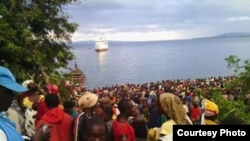Well over 100,000 people have fled Burundi in recent weeks to escape political violence, crossing into Tanzania, Rwanda and DRC.
In Tanzania, the first stop for the refugees is the northern village of Kakunga, which is on the shores of Lake Tanganyika. It’s now very crowded as people wait for boats to take them to their next destination in Tanzania.
Caroline Blayney is the regional humanitarian advisor for the International Rescue Committee and is currently in Kigoma, the second stop for the refugees in Tanzania.She said the village, which is about 500 meters from the border, is the first point of entry for refugees coming from Burundi.
“It is actually a little fishing village,” she said, “that has been now inundated with about 50,000 people.”
Blayney said there are long queues of refugees there.
“When you come up onto the shore you see…about three kilometers long of people lined up and stacked in very tight conditions. People are living literally dwelling to dwelling. The latrines are well within the sight of the housing. You have limited water. People are bathing and drinking from the lake itself. It’s very hectic. And people have very few things.”
Initially, only one boat – a former WWI gunboat -- was available to take the refugees to their next destination. The U.N. refugee agency, UNHCR, says a second vessel has been added, but transportation of refugees remains a very slow process.
“So, the boat is a hundred years old. It’s a German boat that’s been here since 1915. Refugees are taken by smaller fishing dinghies to the boat itself from the shore…Conditions on the boat itself are reasonable and we’re able to deliver medical services while on the boat making the trip,” said Blayney.
The U.N. World Food Program is distributing supplies for those making the three hour voyage.
“The second boat that’s come,” she said, “has a capacity of 300 people. The first boat, the original boat, has a capacity of about 700 people.”
The vessels make two trips per day, carrying 2,000 people.
“Also in terms of the elderly and the sick, getting them onto the boat itself is an issue where you have these little fishing dinghies…So, it’s not ideal, especially when they’re loading patients who need to be evacuated.”
The boats then travel to Kigoma.
“The city, along with the government and UNHCR, has identified a stadium [there] as the official transit center. This is where refugees are registered formally. We do protection screening, health screening.They might spend the night there, and then go by bus to the camp in Nyarungusu.”
Blayney says that it’s a “major logistical challenge. We have 50,000 people and can only move up to 2,000 at a time. You can do the math. We are planning for about eight months of emergency response in both Kagunga and then in Kigoma….The main thing, too, to know is that getting supplies into Kagunga is also a major challenge.”
She said that aid agencies are now renting speed boats to transport staff and supplies on a regular basis, “so that we can ameliorate conditions within Kagunga as we wait to move people.”
The International Rescue Committee is providing primary health care. Some refugees have acute watery diarrhea. Many have burns from stoves from living in such close quarters. The IRC is also trying to get tanks of potable water to the refugees.And, it’s screening them for unaccompanied minors and sexual gender-based violence.
“It’s important to know,” she said, “that the majority of these refugees are women and children…and that they do have very specific needs that do need to be met. Otherwise, the situation will massively deteriorate.”









